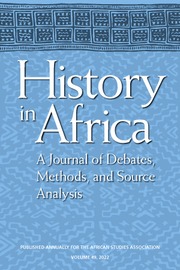| CARVIEW |
- Home
- >Journals
- >History in Africa
- >Volume 32
- >Not Quite Cricket: “Civilization on Trial in South...
- English
- Français
Article contents
Not Quite Cricket: “Civilization on Trial in South Africa”: A Note on the First “Protest Film” Made in Southern Africa
Published online by Cambridge University Press: 09 May 2014
Extract
Michael Scott, the long-term Gandhi-esque opponent of the South African government, was a man of many talents and one of his ignored skills was using a cine-camera. Between 1946 and 1948 as he worked in Tobruk squatter settlement near Johannesburg and environs and traveled to Namibia, in addition to his powerful writing, he also filmed scenes he encountered. The purpose of this note is to share the delight of viewing “Civilization on Trial in South Africa.” It is, as far as I can ascertain, the first “protest” film made in South Africa, yet is not mentioned in the standard histories of film in southern Africa (Cancel 2004, Davis, 1996, Botha/van Aswegen 1992, Tomaselli 1988). While working on another project I fortuitously came across a copy in the Smithsonian Film Archives that I had copied and have deposited in the Namibian Archives.
The Smithsonian catalog dates this 24-minute edited black and white film to ca. 1950, and believes that it was shot between 1946 and 1952, prior to the implementation of the Group Areas Act, although it seems likely that shooting was completed earlier, before Scott was declared a Prohibited Immigrant in the late 1940s. Certainly, reading the documents on Scott's travels to Namibia, it seems likely that portions of his film was shot before 1948. In his autobiography, A Time to Speak, Scott mentioned showing the film in 1949 (Scott 1958:248). The Smithsonian obtained the film from the late Colin Turnbull, an Oxford educated Africanist anthropologist (J. Homiak, personal comment).
Information
- Type
- Research Article
- Information
- Copyright
- Copyright © African Studies Association 2005
Access options
Get access to the full version of this content by using one of the access options below. (Log in options will check for institutional or personal access. Content may require purchase if you do not have access.)Article purchase
Temporarily unavailable
References
- 1
- Cited by
Cited by
Loading...
Save article to Kindle
To send this article to your Kindle, first ensure no-reply@cambridge.org is added to your Approved Personal Document E-mail List under your Personal Document Settings on the Manage Your Content and Devices page of your Amazon account. Then enter the ‘name’ part of your Kindle email address below. Find out more about sending to your Kindle. Find out more about saving to your Kindle.
Note you can select to save to either the @free.kindle.com or @kindle.com variations. ‘@free.kindle.com’ emails are free but can only be saved to your device when it is connected to wi-fi. ‘@kindle.com’ emails can be delivered even when you are not connected to wi-fi, but note that service fees apply.
Find out more about the Kindle Personal Document Service.
- Volume 32
- Rob Gordon
- DOI: https://doi.org/10.1353/hia.2005.0009
Save article to Dropbox
To save this article to your Dropbox account, please select one or more formats and confirm that you agree to abide by our usage policies. If this is the first time you used this feature, you will be asked to authorise Cambridge Core to connect with your Dropbox account. Find out more about saving content to Dropbox.
- Volume 32
- Rob Gordon
- DOI: https://doi.org/10.1353/hia.2005.0009
Save article to Google Drive
To save this article to your Google Drive account, please select one or more formats and confirm that you agree to abide by our usage policies. If this is the first time you used this feature, you will be asked to authorise Cambridge Core to connect with your Google Drive account. Find out more about saving content to Google Drive.
- Volume 32
- Rob Gordon
- DOI: https://doi.org/10.1353/hia.2005.0009


